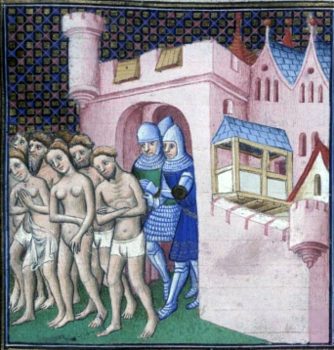The term Cathars comes from Greek word katharoi which means the pure ones. Cathars were also usually known as Albigensians because the city Albi in southern France was in beginning their largest community base. They represented a community that seriously endangered the organization of Catholic Church in the 12th and 13th centuries. The basic characteristic of Cathars was the belief in two principles: good and evil, namely, God and Satan. God was the creator and master of the spiritual world (New Testament), and Satan was the creator of physical world. Since all material things were created by Satan, the perfect life according to belief of Cathars was ascetic life.
Those who were fully devoted to this doctrine have had to keep complete celibacy. They were not allowed to eat food of animal origin except fish and they should not own any personal property. Since this lifestyle was too strict for most of their supporters, Cathars consisted of two groups: perfecti and ordinary unbaptized believers known as credentes. Perfecti were introduced into this title by a ceremony performed by the other two perfecti. This ceremony was known as Consolamentum or transmitting the Holy Spirit to new perfecti. Perfecti were represented some kind of Cathars priests and theologians. As they wore an extremely simple dress and lived completely ascetic life, they represented a striking contrast to the Catholic priesthood that was not poor and whose moral at that time was a sign of affairs.
Believers (credentes) could live a normal life, marry, eat meat and they could have a private property. They only had to receive Consolamentum before death in order to be clean of all previous sin and become perfecti. According to Cathars with this ceremony believers will avoid returning to the material world (reincarnation). As the Consolamentum could not be repeated, many of them before death practiced so called endura (suicide of hunger). In this way, they avoided doing any sin again. The ability to easily achieve salvation and remove all sins in life by only one religious rite made the teaching of the Cathars very attractive to many ordinary Christians. Doctrine of teaching by Cathars is not known completely, but there is a lot of knowledge about the differences between the Cathars and Catholic Church’s teaching, because these questions have been thoroughly explored when the inquisitors interrogated those believers who incorrectly taught (heretics) according to the official Church in Rome.
It is known that they rejected Sacred Mysteries (infant baptism, forgiveness), teaching of hell and purgatory, and disputing any power to the saints. Teaching of Cathars was formed under the influence of religious movement Manichaeism whose origin was territory of Iran. Manicheism firstly spread on Balkan in the form of Bogomilism and later in Europe. The largest number of Cathars in the 12th century was in southern Europe especially in France where they created five diocese. In southern France, Cathari obtained their local support of local nobility. Some nobleman’s greatly accepted this teaching because it was much simpler than the official Church teaching. Others saw the opportunity to reduce the impact of Church in their life or reduce property of Church. Under the protection of influential people, the Catharian perfecti preachers traveled, spread this teaching and they even held public hearings with Roman Catholic priests at the end of the 12th and the beginning of the 13th century. As the Church’s struggle against of Cathars not gave results with classic methods by preaching, excommunication, interdiction, Church started newer radical measures – inquisition and crusades missions.



In November 1184 Pope Lucius III wrote a Ad abolendam or Towards abolishing through which the Albigensian community was excommunicated and he ordered by episcopal courts to conduct investigations against suspects. In 1209, the Church founded the Order of Saint Francis, who emphasizes the propaganda of the cataclysm against the Cathars. Pope Innocent III launched a crusade war against the Cathars in the Languedoc (now Southern France). The level of violence against Cathars was extremely high. At the beginning of the war, crusaders killed around 7,000 inhabitants of town Béziers. On August 15, 1209 crusades were conquered fortified town Carcassonne and they took away all the assets of the population and expelled them naked from the city. The official war against Cathars ended in the Treaty of Paris (1229), but persecutions continued in the coming period. In the thirties of the 14 century, the records of the Inquisition against Cathars were sporadic. The last known Cathar perfecti in the Languedoc, Guillaume Bélibaste, was executed in 1321.
